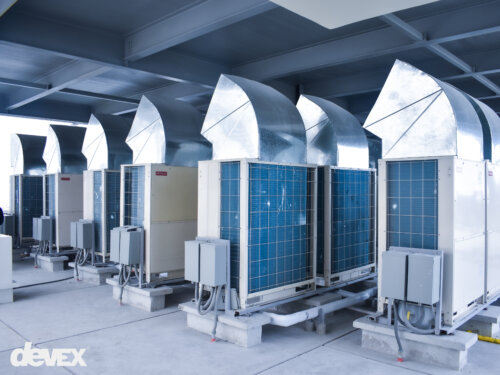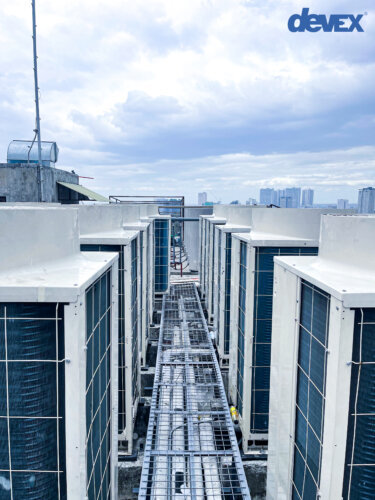
Choosing a heating and cooling system can be confusing, especially when you encounter unfamiliar terms like VRF and VRV. This guide will explain these systems in simple terms and help you decide if they are right for your commercials.
A Matter of Branding
VRV and VRF refer to the same technology. VRV stands for “Variable Refrigerant Volume,” while VRF stands for “Variable Refrigerant Flow.” The difference lies in branding. VRV is a trademark owned by Daikin Industries Ltd. In 1982 when they introduced the first commercially successful VRF system. Daikin is a leading manufacturer and the first of this technology. So, any VRV system you see comes from Daikin. Other brands use the term VRF for similar systems.

VRF systems offer a powerful combination of efficiency, versatility, and quiet operation, making it a compelling choice for modern air conditioning needs.
Today, the term “VRF” is widely used to describe these systems regardless of manufacturer, while “VRV” remains a specific brand name associated with Daikin.

Why Consider VRV/VRF Systems?
- Environmentally Friendly. VRV/VRF systems used heat pump technology to efficiently move heat throughout your building, reducing energy consumption and lowering your electricity bills. These systems contribute to a greener future by achieving energy efficiency ratings. This leads to less environmental impact and potentially lower company expenses.
- Zoned Comfort. Imagine controlling the temperature in each room, VRV/VRF allows you to adjust the temperature in different areas independently. This keeps everyone comfortable, whether it is a chilly office or pleasantly warm conference room.
- Adaptability. VRV/VRF systems work well for many building types due to their adaptability. Their modular design allows customization with multiple indoor units connecting to a single outdoor unit, perfect for zoned control in open floor plans, private offices, and server rooms. A wide range of indoor unit styles such as cassettes, wall-mounted, and ducted units, ensures a perfect fit for any space. While the modular design allows for easy expansion as your business grows. This adaptability for size, layout, and future needs makes VRV/VRF a versatile choice for a wide range of commercial applications.
How Do They Work?
Multi-Indoor and Single-Outdoor. Multiple indoor fan coil units, one powerful single outdoor system unlike traditional systems with a single indoor unit for the whole building, VRV/VRF connects several indoor units to a single powerful outdoor system. This reduces clutter and simplifies maintenance.
Smart Temperature Control. VRV/VRF systems act like climate experts. Each indoor unit adjusts the refrigerant flow based on the specific temperature needs of the room. This targeted approach optimizes energy used.
Heat Recovery. Some VRV/VRF systems can capture heat from one zone like a server room and transfer it to another zone that needs heating, further these VRF/VRV systems can optimize heat from outside air zone to inside zone that circulates fresh air and exhaust air to further reduce energy waste.
Stay Cool, Stay Informed
VRV/VRF systems offer a compelling solution for those seeking energy efficiency, comfort, and zoning control in their buildings. Expand more by understanding their benefits and drawbacks, you can make an informed decision about whether they are the right fit for your needs, or the best is consult with the professionals.
Written by: Christian Kimp Atip


Comments are closed here.